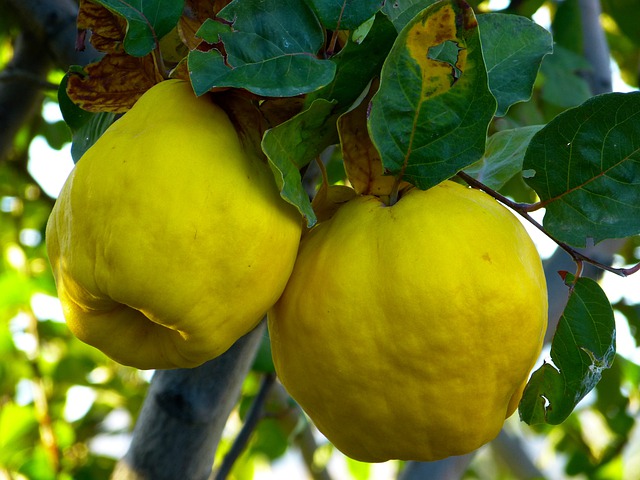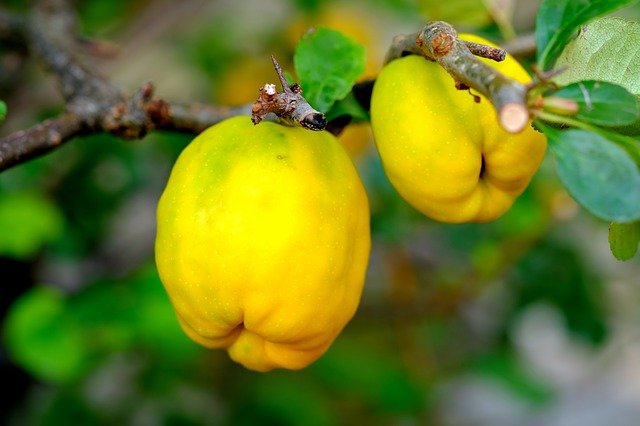When Is Quince Ripe? Identifying a Quince That Has Reached Maturity and Is Ready for Harvest

The best indicator of ripeness is the color of the fruit. At maturity, a mature quince turns entirely yellow. Once the fruit is fully ripe, it emits a strong, sweet scent. The fruit also detaches easily from the tree when it is ripe, so if it begins to fall from the tree on its own, it is ripe and may be approaching overripeness. Even though quinces can keep ripening after they’ve been picked, they taste best when they’ve had time to ripen on the tree.
Table of Contents
How Does Ripe Quince Taste Like?
Ripe quince tastes like a cross between an apple and pear. It is tart and has a slightly sweet flavor that goes well with sweeter foods or drinks. Ripe quince is available year-round but is at its best when they are in season from late winter to early spring. You can buy them pre-cut or uncut, but it’s recommended to cook them yourself as they will not taste as good if they’re not cooked properly.
When eaten fresh, the skin of ripe quinces is soft to the touch and slightly wrinkled. The flesh beneath the skin is light pink, with small seeds distributed throughout it.
The taste of ripe quinces varies depending on where they are grown. Some may have a sweeter flavor, while others are more tart. They’re generally regarded as delicious fruits that can add sweetness and texture to dishes.
Is It Safe To Consume Unripened Prunes?
Unripe quince is neither poisonous nor particularly appetizing. Because of this, it is rarely consumed raw. Most individuals consume quince cooked or raw atop yogurt or oatmeal. It is also a popular addition to pork dishes.
Quince Harvest Time
Quince harvest time officially starts on the first day of September in most parts of North America. Depending on the variety, quinces can be picked at different times throughout the season, but typically they are ready to harvest by early October. When selecting quinces for harvesting, it is important to look for those that are slightly soft and have a slight give when pressed with your thumb. They should also have uniform color and not appear wilted or scorched. Once you’ve selected your quinces, it’s best to handle them as little as possible so that their natural oils remain intact.
How to Harvest Quince
Due to the fruit’s fragility, quince should be harvested with care. Use a pair of sharp garden shears to cut the fruit from the tree. When gathering quince fruit, choose the largest, blemish-free yellow fruit. Do not select fruit that is damaged, bruised, or soft. Once the quinces have been harvested, they should be ripened in a cool, dry, and dark location in a single layer, with daily rotation.
Storing and Ripening a Quince
If you harvest the fruit when it is still greener than golden yellow, you can allow it to ripen in the same manner for six weeks before consuming it. Occasionally, evaluate its ripeness. The quince should not be stored with other fruits. Its pungent odor will taint others. As soon as the fruit is ripe, use it without delay. The fruit will become mealy if left out for too long. Wrapped in paper towels and stored separately from other fruits, quince can be refrigerated for up to two weeks.
Only pick and store fruits that aren’t broken. Put them in shallow trays in a cool, dark place, making sure they don’t touch and not wrap them. Since quinces have a strong scent, you shouldn’t store them with other fruits. Before cooking, let the quinces “mellow” for six to eight weeks. They will last between two and three months.

Dates of Quince Cultivar Ripening
The maturation times of several widely available quince varieties:
| Season | Varieties |
| Early Ripening | Missouri Mammouth |
| Early to Mid Ripening | PortugalPowell’s PrizeDe Vranja |
| Mid-Season Ripening | Apple-shapedChampionOrangeRea’s MammouthSmyrna |
| Mid To Late Season Ripening | Mummery’s SeedlingFuller’sPineapple |
| Late Season Ripening | Master’s EarlyDe Bourgeaut |
| Very Late Season Ripening | Van DemanKarp’s SweetSeker Gevrek |
